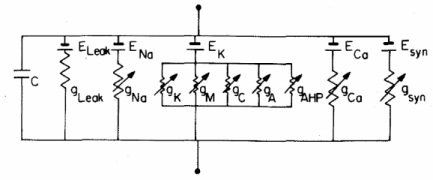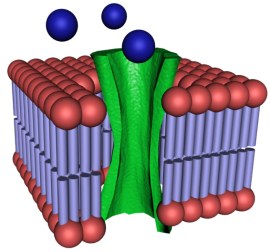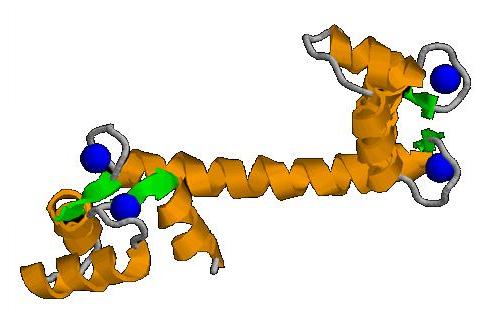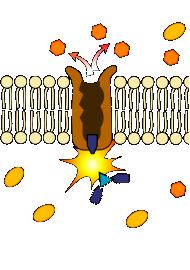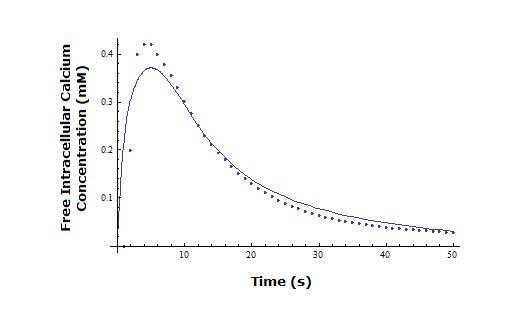Team:Valencia/OurModel
From 2009.igem.org
| Line 3: | Line 3: | ||
<style> | <style> | ||
#content{ | #content{ | ||
| - | height: | + | height: 3550px; |
} | } | ||
</style> | </style> | ||
Revision as of 22:11, 21 October 2009
Detailed model description
We have based our Project on the budding yeast Saccharomyces cerevisiae. Although it is a model organism for the study of many biological processes, there are only a few reports on yeast electrophysiology. That’s why we began to work with a model built up for excitable cells (neurons and cardiomyocites) in which several parts can be distinguished:
- Modelling Ionic Current Flow through VDCCs
If we assume that the whole calcium currents occur through this calcium channels and that the instantaneous current-voltage relation is linear, we can describe the ionic current ICa by the Ohm's law:
Where g is the conductance associated with the channel, V is the transmembrane potential and ECa is the Nerst potential, related to the different ionic concentration inside and outside the cell.
Considering that these channels are only permeable to calcium and have two states -open or closed-, the total conductance associated with the population of VDCCs can be expressed as the maximal conductance ![]() times the fraction of all channels that are open. This fraction is determined by hypothetical activation and inactivation variables m and h, which depend on voltage and time:
times the fraction of all channels that are open. This fraction is determined by hypothetical activation and inactivation variables m and h, which depend on voltage and time:
![]() is the steady-state value of m and
is the steady-state value of m and ![]() is the time constant. They are defined functions of voltage:
is the time constant. They are defined functions of voltage:
K is the halfway inactivation concentration and [Ca2+]o is the constant extracellular calcium concentration.
Now, we have to model how transmembrane potential changes in time. To do this, we can consider the following membrane-equivalent electrial circuit, where all ionic currents involved in initiation and propagation of the action potential are represented:
We can know the transmembrane potential at any time after applying an electrical input by solving this equation:
However, we have assumed that our stimulus triggers the excitatory post-synaptic potential (EPSP), so it's not necessary to solve the previous equation. But modelling the calcium influx is only the first step...
- Modelling Free Intracellular Calcium Concentration
The change in free intracellular calcium concentration is mostly due to the influx of calcium ions described above, but there are several factors which also contribute. For instance, we have considered calcium buffers and calcium remove by membrane pumps.
|
Calcium current F is the Faraday's constant, [Ca2+] is the calcium concentration just below the plasma membrane and Vol is the cell volume considered. |
|
Calcium buffers f and b are the forward and backward rates of the binding reaction:
|
|
Calcium pumps Where [Ca2+]eq is the equilibrium concentration of the pump, [Ca2+] is the calcium concentration in the shell just below the membrane and tpump is the pump's time constant, which depends on voltage: |
|
We have neglected the intracellular diffusion of calcium due to the different concentrations between the inner perimembranal area and deeper areas of the citoplasm, we have considered that the calcium release from intracellular organelles (for instance, endoplasmic reticulum and mitochondria) may reduce these concentration differences. Thus, we assume the calcium concentration just below the plasma membrane as whole intracellular calcium.
In our project, the mechanism for the production of light through a yeast-based system is similar to the one described by the previous model. Therefore, after determining experimentally yeasts’ response to this type of input, we decided to fit the model to our experimental results and determine the differences between neurons and yeasts’ VDCCs (Voltage-Dependent Calcium Channels). In particular, this fitting allowed us to determine the conductance (g) of yeasts’ calcium channels:
It has to be noted that we took into account some particular properties of yeasts’ plasma membrane, for instance, its transmembrane potential, which is so much lower than in neurons.
The following figure shows our experimental data (dotted line) and the theoretical results predicted by our model considering the determined conductance of 21,386 µS:
 "
"





